Key details revealed on Australia’s hosting of the 2027 RWC – and draw timing shapes as issue again

PARIS – The next men’s Rugby World Cup, in Australia in 2027, will have record number of teams with World Rugby expanding to 24 – but it will also be a week shorter.
That will have the impact of decreasing the length of the tournament, removing the bye round from the current tournament which began with four pools of five teams.
World Rugby CEO Alan Gilpin and chairman Bill Beaumont announced changes to the format at a media conference on Wednesday AEDT.
“The decision to expand Rugby World Cup 2027 to 24 teams is logical and the right thing to do,” said Beaumont.
“Underpinned by a new global calendar that increases certainty and opportunity, we are focused on raising standards, closing the gaps and creating a spectacle that fans demand to see. With its love of sport and major events, Australia is the perfect place to do just that.”
The key details are as follows
The dates
The tournament will take six weeks, and seven weekends, as opposed to the current seven weeks and eight weekends. It will run from October 1 to November 13, starting three weeks later than France 2023.
It is understood Rugby Australia was successful in having the date pushed back to avoid clashes with AFL and NRL finals despite some opposition from European club chiefs.
Details of the qualification process and dates for Rugby World Cup 2027 will be determined following a full review of France 2023 and consultation with unions and regions.
The draw
The draw will be held in January 2026 – 22 months before the tournament starts. The draw for France 2023 has been widely criticised as lopsided because it was set on world rankings at December 2020 – almost three years out from the start.
While 22 months still seems a long way out to set the draw, World Rugby CEO Alan Gilpin said the two hemisphere nature of the game meant it needed to be done after the Spring Tour of 2025 and could not wait until after the July-August internationals.
“Is it a recognition this one was too early? I think we’ve said this a few times, I understand that there’s frustration around the draw for this World Cup,” Gilpin said.
(Photo by Chris Hyde/Getty Images)
“The reality is, and sometimes this is a bit lost, we were in the middle of a global pandemic and nobody was playing international rugby at the time the draw was made for this tournament.
“So, we were using effectively the rankings that existed from the end of the last tournament. And that was really important in order to be able to plan for the great tournament that we’ve now had and to give teams and fans and those investing in the tournament, the stakeholders in this tournament, the opportunity to move that planning forwards.
“But of course it leads to the challenges or the frustrations that we’ve had here. There’s always been a recognition that we want to change that, to have the draw closer to the tournament.
“When you actually drill down into that what you quite quickly realise, if you are going to have a draw that is based on the integrity of global rankings in Rugby World Cups, is that there is a relatively narrow window between the end of the November internationals and the start of the next Six Nations in the men’s game when everyone is playing.
“And the moment you go beyond that, some nations have had the opportunity to improve their rankings and some haven’t until the end of the next November internationals.
“We’ve taken the view for the Rugby World Cup in Australia in 2027 that waiting until after the November internationals in 2026 would be too late. I think it would put ticket sales at risk and that puts the financing of the tournament at risk.
“I think fans would be very frustrated at that outcome of not being able to plan with any certainty with less than a year to a Rugby World Cup. And it would make a real challenge, particularly at a time of expansion to 24 teams, to plan for the infrastructure that is needed for that expansion.
“So, the moment we’ve taken the decision not to go as late as effectively 10 months before a Rugby World Cup then we are back to January 2026. So, hopefully again it’s a compromise but a better one than we have now.”
Twelve teams – those who finished in the top three of the four pools in France, have pre-qualified for the tournament, including Australia.
The format
The draw will be six pools of four teams, with the top two advancing to a round of 16 along with the four best third placed teams.
Every team will play three pool games – as opposed to four in 2023 – while the round of 16 added before quarter-finals still allows for the tournament window to be reduced from seven to six weeks while maintaining rest days for players.
The pool phase goes from five weeks to four weeks. It is also expected to lessen the gaps between the games which have been clustered onto weekends in France.
